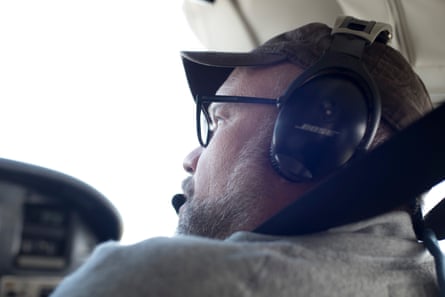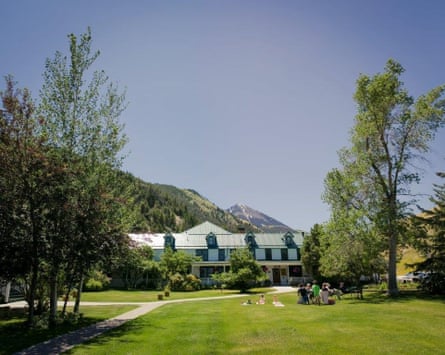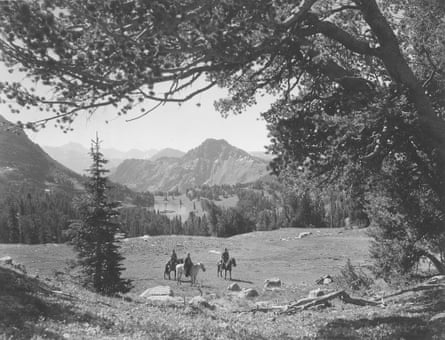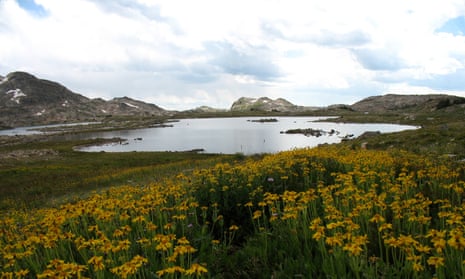Bruce Gordon’s Cessna Centurion floats off the runway south of Livingston, Montana, quickly escaping the confines of Paradise Valley, walled on both sides by the Absaroka and Gallatin mountain ranges. Snaking through the alfalfa fields, cottonwood thickets and ranches below, the Yellowstone river is still surging with late spring snowmelt.
As soon as we crest the ridges, the whole of Yellowstone national park is visible to the south, with Grand Teton towering on the far horizon. Places that would take hours to drive between – because of impassable mountains and roadless wilderness – are revealed to be only a handful of miles apart. The nearly 1m acres of the Absaroka-Beartooth Wilderness is spread out to the east, teeming with unseen elk herds, mountain lions and grizzly bears. Gordon, who runs the nonprofit EcoFlight, based in Aspen, Colorado, pilots flights like this one to help people understand conservation issues with a view from above. “We’re coming up on Emigrant Gulch now,” Joe Josephson, sitting in the co-pilot’s seat, says over the intercom as we fly over the green-roofed buildings of Chico Hot Springs resort, skirting the conical 10,915ft Emigrant Peak. Josephson, an avid mountaineer who recently summited Emigrant Peak to celebrate his 50th birthday, is the Montana Conservation Associate for the Greater Yellowstone Coalition, a nonprofit devoted to defending the 20m-acre Yellowstone ecosystem from degradation.

We have taken to the skies on this late June morning to view the sites on the northern fringe of Yellowstone Park where two mining companies want to dig exploratory holes thousands of feet into the mountains. The Paradise Valley – as this stretch of the Yellowstone river valley between the park and Livingston is known – is no stranger to hard-rock mining. The town of Emigrant, at the foot of the iconic peak that bears its name, was settled by miners in the late 1800s, when the area was still Crow country. Right on the edge of what would eventually become Yellowstone national park, miners built the village of Jardine, where the last industrial gold mine shut its doors in 1996.
But these days, mining is mostly a relic of history in the Paradise Valley, where tourism and outdoor recreation have long since seized the reins of the regional economy. In November 2016, responding to outcry from local business and residents over the perceived threats posed by the dual mining proposals, former interior secretary Sally Jewell announced a two-year moratorium on new mineral leases on 30,000 acres of federal public land in the Paradise Valley. In April of this year, Montana senator Jon Tester, a Democrat, introduced a bill that would make the moratorium permanent. Mine opponents are thrilled, but the bill faces a hard road forward in a Senate dominated by Republicans who share President Trump’s commitment to expanding the extractive industries’ footprint on public land.

Gordon wheels around to the east, giving us a view of a rarely seen bowl beneath the north face of Emigrant Peak, bare of snow and striped with rusty hues. “That’s the St Julian Claim,” Josephson says, indicating an area of private land several acres wide, flanked on all sides by the Custer-Gallatin national forest. “That’s where Lucky Minerals wants to drill.”
The reddish stains are the result of materials in the sulfide ore body that react to air and water and have the potential to produce acid runoff. They’re also an indication of what may be hidden below: gold. Lucky Minerals, a Canadian company, is behind the Emigrant Gulch project, an exploratory operation that would involve 46 drill holes on 23 pads, and in Lucky’s best case scenario, would result in the discovery of gold deposits significant enough to merit industrial development.
Crevice Mountain Mining, which is majority Australian-owned, is pursuing a separate exploration project in the hills above Jardine, almost within sight of the Roosevelt Arch, Yellowstone’s historic entrance. Locals worry that industrial mining on the site might contaminate the river and the aquifer below, with disastrous results for the hundreds of businesses that rely on the upper Yellowstone river watershed, the surrounding mountains, and the national park to draw the tourists who spend about $1bn annually in the five counties surrounding Paradise Valley – dollars that generate 13,520 jobs, according to research compiled by Dr Larry Swanson, an economist who runs the University of Montana’s Center for the Rocky Mountain West.
Concerns over the perceived threat to the watershed have prompted more than 350 Montana businesses and organizations to join the Yellowstone Gateway Business Coalition, which formed in 2015 with the goal of blocking new mining permits on the forest service land adjacent to Emigrant Gulch, and later expanded its objective to include the area around the proposed Crevice site. The members include an unlikely mix of old-school hunting outfitters and ranchers and “new west” businesses like Livingston’s Katabatic Brewing Company and the Flying Pig Raft Company in Gardiner. There are also some international heavy-hitters on the roster, including Costa Sunglasses, Orvis and Simms Fishing Products, a manufacturer of Gore-Tex fishing waders and apparel that employs 180 people at its headquarters and factory outside Bozeman. As one member told me: “We have people with peace sign bumper stickers on the backs of their Subarus and folks who think Rush Limbaugh is too liberal.”
The coalition represents a new political force in the western US that is flexing its muscles on behalf of conservation and environmental prerogatives and starting to compete with traditional political powerhouses – the agricultural and extractive industries – for the attention of elected officials. The coalition’s slogan, plastered on bumpers and yard signs all over southwest Montana, is “Yellowstone is more valuable than gold”.

Of course, for anyone who might want to work on the exploration projects, the slogan falls flat. Dr Michael Werner, an engineer who is spearheading the Crevice Mountain proposal, told the Billings Gazette that a fully operational mine on the site would bring in about $7.5m in annual wages to Park County. Werner’s forecasts aren’t drawn from thin air – the Mineral Hill mine, which operated close to the Crevice site until 1996, employed 120 and had a $7m annual payroll. Historically, dreams of the next grubstake haven’t been hard to sell in Montana, where the state flag bears the slogan “Oro y Plata” or “Gold and Silver” beneath a tableau that includes mountains, a shovel and a pick.
While the heyday of mining in Montana has long passed, the industry remains one of the state’s economic pillars. Two valleys over, on the edge of the same Absaroka-Beartooth Wilderness that flanks the proposed Paradise Valley mines, the Stillwater Mining Company employs 1,400 workers at the country’s only platinum-palladium mining operation. In May 2017, Stillwater sold to a South African firm for $2.2bn.
Mine supporters highlight the fact that the 1978 law that designated the boundaries of the Absaroka-Beartooth Wilderness intentionally excluded both the Emigrant Gulch and Crevice Mountain sites because of their mineral potential and their historic mining activity. They’re concerned that Senator Jon Tester’s bill could set a precedent that would encourage environmental activists to fight for more permanent legislative withdrawals. Tester, a Democrat from Montana, has introduced a new bill that would permanently bar new mineral leases on 30,000 acres of federal forest land north of Yellowstone Park, to include the areas around the proposed gold exploration sites.
But mine opponents say that the times and the priorities have changed in places like Paradise Valley. As in much of Montana, the tourism and recreation economy is the undisputed king in Park County, which links Interstate 90 – a major thoroughfare for western roadtrippers – to the northern entrance to Yellowstone Park, one of just five entrances through which more than 4 million visitors passed last year. Even businesses that have no direct tie-in to the outdoor industry, like Livingston’s Printing for Less – a founding member of the YGBC – still rely on the area’s world-class natural assets to recruit and retain employees. They’re quick to point out that the leisure and hospitality sector – just one of several sectors tied to tourism and recreation – accounts for over 65,000 jobs in Montana, whereas mining and logging, which are lumped together, account for about 7,300, according to the US Bureau of Labor Statistics.
But if you’re one of the few thousand people in Montana who make a living off hard rock, the prospect of working at one of two new gold mines in Yellowstone country for a six-figure wage is probably more appealing than slinging beers at a brewery or working a season on the river as a raft or fishing guide. And you’re probably short on sympathy for the concerns of real estate brokers who fear that the proximity of the mines might diminish the value of multimillion dollar vacation ranches.
The rub, according to Josephson, is that not all mines, or mining jobs, are created equal. He argues that the Stillwater mine is vital because it’s the nation’s only source of platinum and palladium ore, and one of only two such mines in North America. Platinum and palladium are used in the manufacture of catalytic converters, which reduce the toxicity of vehicle exhaust gases. By contrast, there are several dozen industrial gold mines scattered across the western US with 3,000 tonnes of proven in-ground reserves – in a word, the US isn’t desperate for gold the way it is for platinum and palladium. Additionally, Stillwater County, the site of the platinum-palladium mine and its associated smelters, is heavily dependent on the economic activity generated by the mines, whereas Park County is heavily dependent on tourism and recreation and the pristine natural beauty required to keep the visitors coming.
“Usually these kinds of mining jobs are very short term, and the real jobs come around in the cleanup after the mines have been built,” said KC Walsh, president of Simms Fishing Products, referring to the type of gold mining activity that might result from the proposed exploration.
Montana’s groundwater and landscapes have paid a heavy price for the wealth generated by the state’s mining history: there are eleven mining-related Superfund sites in Montana, areas designated by the Environmental Protection Agency as so polluted that they require long term, federally administered mitigation efforts.
“What we’re trying to do here at Simms is provide jobs that give good compensation, that will last a long time, and help support our state,” Walsh said.
Tammy Johnson, executive director of the Montana Mining Association, said she understands that people are “afraid of the unknown”, but she thinks the outcry over the exploration proposals puts the cart before the horse. “These projects have a long way to go before anything would or could become a mine. These are both just exploration projects that have to be analyzed and permitted by the state,” she said. Referring to Senator Tester’s bill to permanently block new mineral leases in the area, Johnson said: “We’re kind of proposing a nuclear option for something at this point that doesn’t warrant it.”

In December 2016, before his nomination as Sally Jewell’s replacement, former Montana congressman Ryan Zinke expressed his opposition to gold mining in the Paradise Valley. His replacement, Greg Gianforte, a Republican from Bozeman, also opposes the mines, though he has not commented on Senator Tester’s bill.
Currently, both mining companies are working with the Montana department of environmental quality to get permission to drill on private land, but according to Josephson, “There’s only one outcome or goal of exploring and that’s to dig a big mine.” To dig an industrial-scale mine at either site would require expanding onto public land, Josephson said. “There’s less than a half ounce of gold per ton of ore. They’d have to take out tons of rock.”
Along with the specter of poisonous runoff, mine opponents worry about the disturbance to the serene Paradise Valley that would be caused by convoys of heavy trucks laden with ore and the noise of drilling equipment. Of all the businesses aligned with the coalition, Chico Hot Springs resort – over a century old, beloved by locals and tourists alike – would have the worst seat in the house: the forest road that leads up to the St Julian drill site runs straight through the resort’s parking area. Karrie Kahle, Chico’s special events coordinator, summed up the community’s feelings bluntly: “The mines are a threat to our way of life.”
The Trump administration has made it clear that as far as they’re concerned, public land is open for business. But there’s still a lot of red tape between the proposed exploration projects in the Paradise Valley and the realization of industrial gold mines on the sites.
Still, Kahle and her allies are determined to prevent the proposals from even entering into a federal permitting and leasing process that they believe privileges industry over communities. Referring to Senator Tester’s bill, she said: “It would be nice to get the kill shot now.”

Comments (…)
Sign in or create your Guardian account to join the discussion